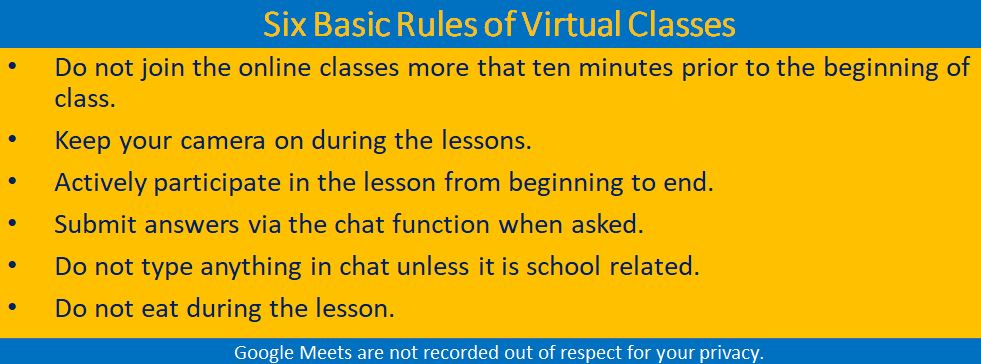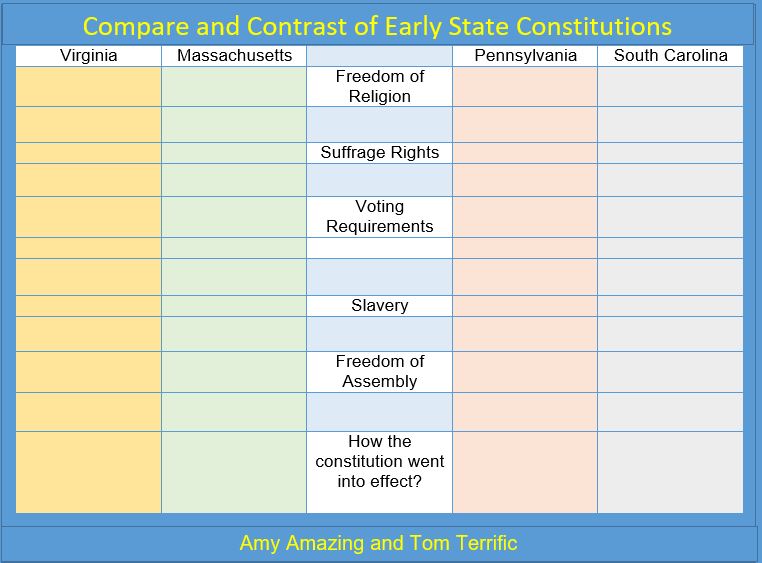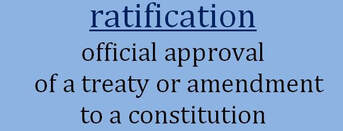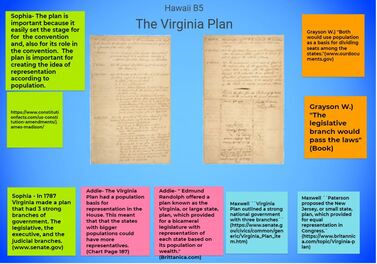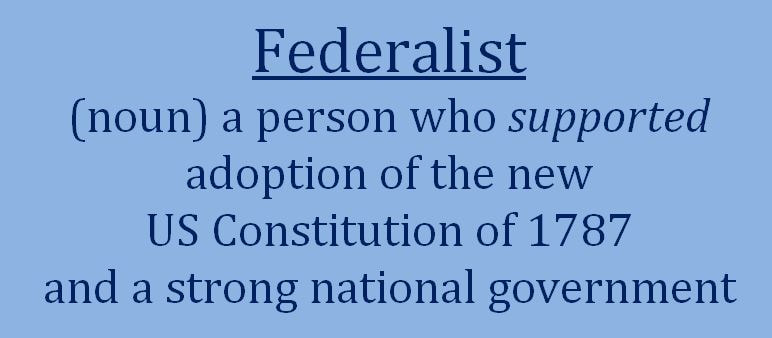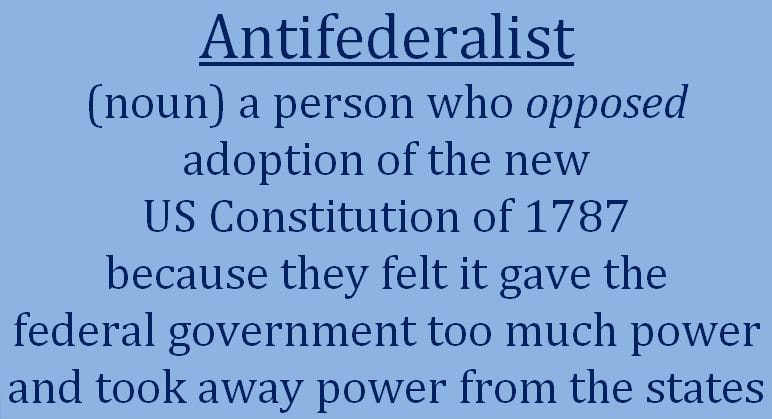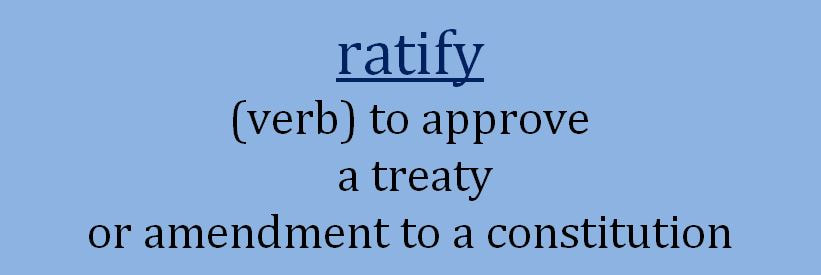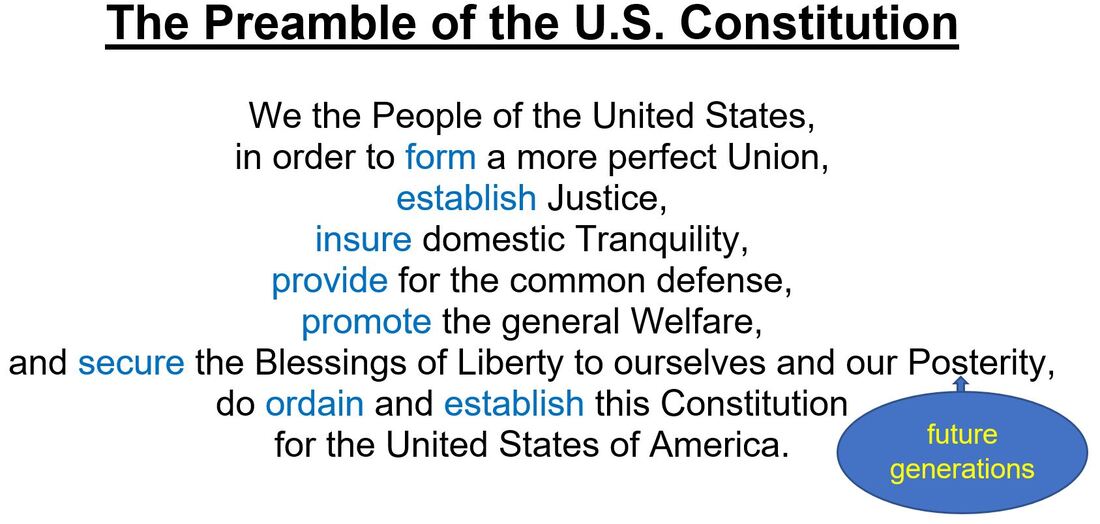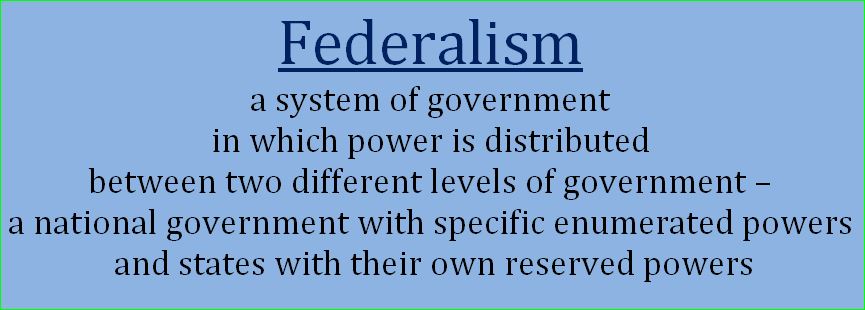U.S. History - Semester 2
US Lesson 19 Part 2 - Pennsylvania Constitution of 1776
Critical Vocabulary Words
During the Revolutionary Era the British colonial government was replaced briefly with a Council of Safety. Their task was to create a constitution for Pennsylvania. The final constitution was not voted on by the people and went into effect on September 28, 1776.
The following are characteristics of the Pennsylvania Constitution of 1776.
- Article 1 stated "all men are born equally free and independent, and have certain natural, inherent and inalienable rights..."
- Article 2 expressed the right of freedom of religion
- Article 4 expressed that government officials were accountable to the people
- Article 11 expressed the right to a trial by jury
- Article 13 expressed the right to bear arms
- Article 16 expressed freedom of assembly by the people
While Pennsylvania was operated under the Constitution of 1776 the Supreme Executive Council passed the Divestment Act of 1779. This act confiscated 24,000.000 acres of land from and then compensated the Penn family. Another act, called the Gradual Abolition Act of 1780 was also passed and was one of the first acts of its kind. Click on the link below to learn more about this important law.
Critical Vocabulary Words
- emancipation
- manumission
During the Revolutionary Era the British colonial government was replaced briefly with a Council of Safety. Their task was to create a constitution for Pennsylvania. The final constitution was not voted on by the people and went into effect on September 28, 1776.
The following are characteristics of the Pennsylvania Constitution of 1776.
- the Pennsylvania Legislature consisted of a unicameral legislature called the Assembly
- instead of a chief executive (governor) there was a Supreme Executive Council
- it included a Declaration of Rights
- Article 1 stated "all men are born equally free and independent, and have certain natural, inherent and inalienable rights..."
- Article 2 expressed the right of freedom of religion
- Article 4 expressed that government officials were accountable to the people
- Article 11 expressed the right to a trial by jury
- Article 13 expressed the right to bear arms
- Article 16 expressed freedom of assembly by the people
While Pennsylvania was operated under the Constitution of 1776 the Supreme Executive Council passed the Divestment Act of 1779. This act confiscated 24,000.000 acres of land from and then compensated the Penn family. Another act, called the Gradual Abolition Act of 1780 was also passed and was one of the first acts of its kind. Click on the link below to learn more about this important law.
US Lesson 20 - 4.1 State Constitutions
DoDEA Standard 7.4 HISTORICAL DEVELOPMENT OF THE CONSTITUTION
The newly independent states faced political and economic struggles under the Articles of Confederation. These
challenges resulted in a Constitutional Convention, a debate over ratification, and the eventual adoption of the
Bill of Rights.
7.4b The lack of a strong central government under the Articles of Confederation presented numerous challenges. A convention was held to revise the Articles, the result of which was the Constitution. The Constitution established a democratic republic with a stronger central government.
The newly independent states faced political and economic struggles under the Articles of Confederation. These
challenges resulted in a Constitutional Convention, a debate over ratification, and the eventual adoption of the
Bill of Rights.
7.4b The lack of a strong central government under the Articles of Confederation presented numerous challenges. A convention was held to revise the Articles, the result of which was the Constitution. The Constitution established a democratic republic with a stronger central government.
- Students will examine the Constitutions of various states, their main ideas and provisions, and their influence on the formation of the United States Constitution.
Due- Planner Check Q3 #1 - Due at 7:59 AM
US Lesson 20 State Constitutions - New Hampshire
Today's class assignment focuses on the New Hampshire Constitution of 1776. This constitution is really different! It is the task of your group to figure how! Follow the instructions in class so that you can complete this assignment. Participation points will be based on your responses. There is no homework today.
US Lesson 20 Part 2 - Constitutions Overview
Today's class assignment focuses on an article about early American state constitutions. It provides good information about the various state constitutions and how they were different. We will begin reading the article in class, but you will need to finish reading it for homework.
Assignment- Demonstrate how the early state constitutions were similar and how they were different. Include significant facts, interesting details, and make it interesting.
Proposal Requirements
Today's class assignment focuses on the New Hampshire Constitution of 1776. This constitution is really different! It is the task of your group to figure how! Follow the instructions in class so that you can complete this assignment. Participation points will be based on your responses. There is no homework today.
US Lesson 20 Part 2 - Constitutions Overview
Today's class assignment focuses on an article about early American state constitutions. It provides good information about the various state constitutions and how they were different. We will begin reading the article in class, but you will need to finish reading it for homework.
Assignment- Demonstrate how the early state constitutions were similar and how they were different. Include significant facts, interesting details, and make it interesting.
Proposal Requirements
- Will you work alone or with a classmate?
- What type of presentation will you do? (PowerPoint, Movie, Poster, etc...)
- What are the four states that you will focus on?
|
PowerPoint Requirements
Note- Do not send questions about the assignment via email. Use the Google Meet open sessions (noon-1:00) to ask questions about this project. |
Example of the Sixth PowerPoint Slide
The slide that is shown below is an example of the sixth slide. It meets the basic requirements of comparing and contrasting at least five different topics in the four state constitutions. Obviously it is missing the "details," but it gives you an idea of how you might present your information. |
Homework - Finish reading the article for homework. Then, write a proposal that you can submit in class on Tuesday. Use the following guide to help you organize your thoughts.
US Lesson 21 - 4.1 State Constitutions and the Articles of Confederation
DoDEA Standard 7.4 HISTORICAL DEVELOPMENT OF THE CONSTITUTION
The newly independent states faced political and economic struggles under the Articles of Confederation. These
challenges resulted in a Constitutional Convention, a debate over ratification, and the eventual adoption of the
Bill of Rights.
7.4b The lack of a strong central government under the Articles of Confederation presented numerous challenges. A convention was held to revise the Articles, the result of which was the Constitution. The Constitution established a democratic republic with a stronger central government.
The newly independent states faced political and economic struggles under the Articles of Confederation. These
challenges resulted in a Constitutional Convention, a debate over ratification, and the eventual adoption of the
Bill of Rights.
7.4b The lack of a strong central government under the Articles of Confederation presented numerous challenges. A convention was held to revise the Articles, the result of which was the Constitution. The Constitution established a democratic republic with a stronger central government.
- Students will investigate the successes and failures of the Articles of Confederation, determine why many felt a new plan of government was needed, and explain how the United States Constitution attempted to address the weaknesses of the Articles.
- Students will examine the Constitutions of various states, their main ideas and provisions, and their influence on the formation of the United States Constitution.
US Lesson 21 Part 1 - Early State Constitutions Wrap-up
Today we will wrap-up own class lessons on the early American state constitutions. You will work with your cooperative learning groups to complete and submit the written assignment by 8:59 / 10:59 (end of class). Each student will work complete his or her own assignment and submit it in Google Classroom.
Homework - You will continue to work on your state constitutions project and be at least half-way finished by Wednesday. Be ready to share you work so that you can demonstrate that you are at least half-way finished; this will be a graded check of your partially completed project.
US Lesson 21 Part 2 - Articles of Confederation
Today we will wrap-up own class lessons on the Articles of Confederation. You will work with your cooperative learning groups to complete and submit the written assignment by 8:59 / 10:59 (end of class). Each student will work complete his or her own assignment and submit it in Google Classroom. Remember to click "Turn In" before leaving the Meet.
US Lesson 21 Part 3 - Early US State Constitutions / Articles of Confederation Wrap-up
Today we will wrap-up own class lessons on the early American state constitutions. You will work with your cooperative learning groups to complete and submit the written assignment by 8:59 / 10:59 (end of class). Each student will work complete his or her own assignment and submit it in Google Classroom.
Homework - You will continue to work on your state constitutions project and be at least half-way finished by Wednesday. Be ready to share you work so that you can demonstrate that you are at least half-way finished; this will be a graded check of your partially completed project.
US Lesson 21 Part 2 - Articles of Confederation
Today we will wrap-up own class lessons on the Articles of Confederation. You will work with your cooperative learning groups to complete and submit the written assignment by 8:59 / 10:59 (end of class). Each student will work complete his or her own assignment and submit it in Google Classroom. Remember to click "Turn In" before leaving the Meet.
US Lesson 21 Part 3 - Early US State Constitutions / Articles of Confederation Wrap-up
US Lesson 22 - 4.2 The U.S. Constitution
DoDEA Standard 7.4 HISTORICAL DEVELOPMENT OF THE CONSTITUTION
The newly independent states faced political and economic struggles under the Articles of Confederation. These challenges resulted in a Constitutional Convention, a debate over ratification, and the eventual adoption of the Bill of Rights.
7.4b The lack of a strong central government under the Articles of Confederation presented numerous challenges. A convention was held to revise the Articles, the result of which was the Constitution. The Constitution established a democratic republic with a stronger central government.
The newly independent states faced political and economic struggles under the Articles of Confederation. These challenges resulted in a Constitutional Convention, a debate over ratification, and the eventual adoption of the Bill of Rights.
7.4b The lack of a strong central government under the Articles of Confederation presented numerous challenges. A convention was held to revise the Articles, the result of which was the Constitution. The Constitution established a democratic republic with a stronger central government.
US Lesson 22 Part 1 - Drafting a Constitution
Over the past few weeks you have been learning about the various state constitutions in original thirteen colonies. The ideas and government structures that were created in these constitutions helped to form a new constitution for the country. But, the debate to create the new constitution involved a lot of time and compromise.
Why was there a need for a new constitution? Look at DoDEA standard 7.4b!
Focus - As you read the text, focus on the following topics and be able to identify and explain the main points of each term. It is especially important that you focus on the information provided on the diagram on page 187.
Over the past few weeks you have been learning about the various state constitutions in original thirteen colonies. The ideas and government structures that were created in these constitutions helped to form a new constitution for the country. But, the debate to create the new constitution involved a lot of time and compromise.
Why was there a need for a new constitution? Look at DoDEA standard 7.4b!
Focus - As you read the text, focus on the following topics and be able to identify and explain the main points of each term. It is especially important that you focus on the information provided on the diagram on page 187.
During the Friday virtual lesson you will be asked to submit three sentences that answer the question shown in gold. Remember to provide evidence from the textbook in the form of a quote. The expectation is that you will prepare your response in advance and be ready to paste it in the chat box at the beginning of the lesson. This is a graded assignment.
Was the "Great Compromise" fair to small states?
US Lesson 22 Part 2 - Submit Chat Response / Drafting a Constitution Jamboard Activity
Work with your group today to complete the following activity. You will create two Jamboard slides, one focused on Virginia Plan, and the other will focus on the New Jersey Plan. Use the two sources to collect information about each topic. Also, include a picture for each slide from the Library of Congress. Your group is dismissed when there are eight notes and one picture on each slide.
Was the "Great Compromise" fair to small states?
US Lesson 22 Part 2 - Submit Chat Response / Drafting a Constitution Jamboard Activity
Work with your group today to complete the following activity. You will create two Jamboard slides, one focused on Virginia Plan, and the other will focus on the New Jersey Plan. Use the two sources to collect information about each topic. Also, include a picture for each slide from the Library of Congress. Your group is dismissed when there are eight notes and one picture on each slide.
|
Instructions
|
US Lesson 23 - 4.2 The U.S. Constitution
DoDEA Standard 7.4 HISTORICAL DEVELOPMENT OF THE CONSTITUTION
The newly independent states faced political and economic struggles under the Articles of Confederation. These challenges resulted in a Constitutional Convention, a debate over ratification, and the eventual adoption of the Bill of Rights.
7.4b The lack of a strong central government under the Articles of Confederation presented numerous challenges. A convention was held to revise the Articles, the result of which was the Constitution. The Constitution established a democratic republic with a stronger central government.
The newly independent states faced political and economic struggles under the Articles of Confederation. These challenges resulted in a Constitutional Convention, a debate over ratification, and the eventual adoption of the Bill of Rights.
7.4b The lack of a strong central government under the Articles of Confederation presented numerous challenges. A convention was held to revise the Articles, the result of which was the Constitution. The Constitution established a democratic republic with a stronger central government.
US Lesson 23 Part 1 - Drafting a Constitution Jamboard Activity II
Today you will work with your group to finish the US Constitution Jamboard assignment. The third slide will be titled "Three-fifths Compromise" and the fourth will be titled "The Great Compromise." Use your textbook and link below as your sources. Also, include a picture for each slide from the Library of Congress. All students are expected to work closely with their groups until the end of class or until the assignment is complete.
Important - Include your initials, the page number or site name where you found the information, and a full quote from the source.
Today you will work with your group to finish the US Constitution Jamboard assignment. The third slide will be titled "Three-fifths Compromise" and the fourth will be titled "The Great Compromise." Use your textbook and link below as your sources. Also, include a picture for each slide from the Library of Congress. All students are expected to work closely with their groups until the end of class or until the assignment is complete.
Important - Include your initials, the page number or site name where you found the information, and a full quote from the source.
Your group is dismissed when there are eight notes and one picture on each slide.
US Lesson 23 Part 2 - Drafting a Constitution Class Page 190 Assignment
Create a Google Doc and complete the following assignment. Begin by saving it as your last name and the assignment name. Then create the proper heading in the upper-left-hand corner of the page. Type each of the five questions and put them in bold. Answer each question using complete sentences and provide evidence from the text to support your answers. All answers require at least one quote with a page number. Submit your completed assignment by 2:35 today.
Create a Google Doc and complete the following assignment. Begin by saving it as your last name and the assignment name. Then create the proper heading in the upper-left-hand corner of the page. Type each of the five questions and put them in bold. Answer each question using complete sentences and provide evidence from the text to support your answers. All answers require at least one quote with a page number. Submit your completed assignment by 2:35 today.
HW- Reading Assignment 4.3 Ideas That Influenced the Constitution / Prepare Gold Question Response
Prepare and submit this gold question prior to the beginning of class on Tuesday. Make sure you add a heading (name, date, Duncan - Block _" and the title of the assignment. Your response must answer the question shown in gold below and use evidence from the text. Use one quote plus two other sentences that are written in your own words. This is a graded assignment.
Prepare and submit this gold question prior to the beginning of class on Tuesday. Make sure you add a heading (name, date, Duncan - Block _" and the title of the assignment. Your response must answer the question shown in gold below and use evidence from the text. Use one quote plus two other sentences that are written in your own words. This is a graded assignment.
Who was John Locke and why is he considered a major figure of the Enlightenment?
Hint- What Locke ideas were so earthshaking that they ended up helping to shape the US Constitution?
Hint- What Locke ideas were so earthshaking that they ended up helping to shape the US Constitution?
US Lesson 24 - 4.3 Ideas That Influenced the Constitution
DoDEA Standard 7.4 HISTORICAL DEVELOPMENT OF THE CONSTITUTION
The newly independent states faced political and economic struggles under the Articles of Confederation. These challenges resulted in a Constitutional Convention, a debate over ratification, and the eventual adoption of the Bill of Rights.
7.4b The lack of a strong central government under the Articles of Confederation presented numerous challenges. A convention was held to revise the Articles, the result of which was the Constitution. The Constitution established a democratic republic with a stronger central government.
The newly independent states faced political and economic struggles under the Articles of Confederation. These challenges resulted in a Constitutional Convention, a debate over ratification, and the eventual adoption of the Bill of Rights.
7.4b The lack of a strong central government under the Articles of Confederation presented numerous challenges. A convention was held to revise the Articles, the result of which was the Constitution. The Constitution established a democratic republic with a stronger central government.
Due Planner / Gold Question Response
US Lesson 24 Part 1 4.3 Ideas That Influenced the Constitution Class Assignment-
Complete questions one, three, and five only on page 196. Create a Google Doc and complete the following assignment. Begin by saving it as your last name and the assignment name. Create the heading and put it in the upper-left-hand corner of the page. Type the questions, put them in bold, and then add the title and instructions. Answer each question using complete sentences and provide evidence from the text to support your answers. All answers require at least one quote with a page number. Submit your completed assignment by the end of class today.
US Lesson 24 Part 2 4.3 Jamboard Breakout Room Activity
Work with your group today to complete the following activity. Create a Jamboard and name it using the following example- "Feb. 18 B4 Texas - Chris, Mary, Bill, and Becky" You will create three Jamboard slides with the following topics: Republic, English Influences, and American Influences. Each member of the group will find a quote from the chapter post it with a sticky note. Include the quote, the page number, and your fist name on each sticky note. Your group is dismissed when each member has added two sticky notes for each of the three topics. This assignment is due at the end of class today.
Note- Students who are absent from class must complete this activity on their own and submit it by 2:35 tomorrow.
Homework- None (Other than your planner!)
US Lesson 24 Part 1 4.3 Ideas That Influenced the Constitution Class Assignment-
Complete questions one, three, and five only on page 196. Create a Google Doc and complete the following assignment. Begin by saving it as your last name and the assignment name. Create the heading and put it in the upper-left-hand corner of the page. Type the questions, put them in bold, and then add the title and instructions. Answer each question using complete sentences and provide evidence from the text to support your answers. All answers require at least one quote with a page number. Submit your completed assignment by the end of class today.
US Lesson 24 Part 2 4.3 Jamboard Breakout Room Activity
Work with your group today to complete the following activity. Create a Jamboard and name it using the following example- "Feb. 18 B4 Texas - Chris, Mary, Bill, and Becky" You will create three Jamboard slides with the following topics: Republic, English Influences, and American Influences. Each member of the group will find a quote from the chapter post it with a sticky note. Include the quote, the page number, and your fist name on each sticky note. Your group is dismissed when each member has added two sticky notes for each of the three topics. This assignment is due at the end of class today.
Note- Students who are absent from class must complete this activity on their own and submit it by 2:35 tomorrow.
Homework- None (Other than your planner!)
US Lesson 25 - 4.4 Federalist, Antifederalists, and the Bill of Rights
DoDEA Standard 7.4 HISTORICAL DEVELOPMENT OF THE CONSTITUTION
The newly independent states faced political and economic struggles under the Articles of Confederation. These challenges resulted in a Constitutional Convention, a debate over ratification, and the eventual adoption of the Bill of Rights.
7.4b The lack of a strong central government under the Articles of Confederation presented numerous challenges. A convention was held to revise the Articles, the result of which was the Constitution. The Constitution established a democratic republic with a stronger central government.
The newly independent states faced political and economic struggles under the Articles of Confederation. These challenges resulted in a Constitutional Convention, a debate over ratification, and the eventual adoption of the Bill of Rights.
7.4b The lack of a strong central government under the Articles of Confederation presented numerous challenges. A convention was held to revise the Articles, the result of which was the Constitution. The Constitution established a democratic republic with a stronger central government.
|
US Lesson 25 Part 1 Federalists, Antifederalists, and Bill of Rights
Key Terms
|
Objectives
|
US Lesson 25 Part 2 4.4 Federalists, Antifederalists, and the Bill of Rights
Read the first half of the chapter and stop at the bottom of page 199. Consider the following questions...
US Lesson 25 Part 3 4.4 The Ratification Process and New Amendments
US Lesson 25 Part 2 4.4 Federalists, Antifederalists, and the Bill of Rights
Read the first half of the chapter and stop at the bottom of page 199. Consider the following questions...
- Who was George Mason where was he from?
- Why was George Mason an Antifederalist?
US Lesson 25 Part 3 4.4 The Ratification Process and New Amendments
US Lesson 25 Part 4 The Federalist Papers and The Preamble of the U.S. Constitution
Asynchronous Assignment - Complete the Test Study Guide
Write your name and class in the upper-left-hand corner of the paper. Use the US History textbook, lesson page (content and links), and online class glossary to complete this assignment. All definitions must come from the class glossary. Answer all of the questions, including the extra-credit, using a pen. Submit one clear picture of the front and one clear picture of the back. (Due March 1st 7:59 AM)
Write your name and class in the upper-left-hand corner of the paper. Use the US History textbook, lesson page (content and links), and online class glossary to complete this assignment. All definitions must come from the class glossary. Answer all of the questions, including the extra-credit, using a pen. Submit one clear picture of the front and one clear picture of the back. (Due March 1st 7:59 AM)
US Lesson 26 - 4.5 Understanding the Constitution
DoDEA Standard 7.5 THE CONSTITUTION IN PRACTICE
The United States Constitution serves as the foundation of the United States government and outlines the rights
of citizens. The Constitution is considered a living document that can respond to political and social changes.
7.5a The Constitution outlined a federalist system of government that shares powers between the federal, state,
and local governments.
7.5b The Constitution established three branches of government as well as a system of checks and balances that
guides the relationship between the branches. Individual rights of citizens are addressed in the Bill of Rights.
7.5c While the Constitution provides a formal process for change through amendments, the Constitution can respond to change in other ways.
7.5d Foreign and domestic disputes tested the strength of the Constitution, particularly the separation of powers, the system of checks and balances, and the issue of States rights. The United States sought to implement isolationism while protecting the Western Hemisphere from European interference.
The United States Constitution serves as the foundation of the United States government and outlines the rights
of citizens. The Constitution is considered a living document that can respond to political and social changes.
7.5a The Constitution outlined a federalist system of government that shares powers between the federal, state,
and local governments.
7.5b The Constitution established three branches of government as well as a system of checks and balances that
guides the relationship between the branches. Individual rights of citizens are addressed in the Bill of Rights.
7.5c While the Constitution provides a formal process for change through amendments, the Constitution can respond to change in other ways.
7.5d Foreign and domestic disputes tested the strength of the Constitution, particularly the separation of powers, the system of checks and balances, and the issue of States rights. The United States sought to implement isolationism while protecting the Western Hemisphere from European interference.
US Lesson 26 Part 1 4.5 Understanding the Constitution Pages 203-207
- What basic goals of the Constitution are reflected in the Preamble?
- What are the seven basic principles of the U.S. Constitution?
US Lesson - ELA Focus Day (The Compare and Contrast Essay)
Homework- Study for the US History Test
|
Due- Test Study Guide / US Lesson 26 Part 3 4.5 Understanding the Constitution
Test Q3-1 / US Lesson 26 Part 3 4.5 Understanding the Constitution
|
Three Levels of Government National Government (Highest Level) State Government Local Government (Lowest Level) |
Homework Complete and Study - US Lesson 27 U.S. Government and Vocabulary Practice Quiz
Use the information discussed in class, the textbook, lesson pages, and the online class glossaries to complete this assignment. This assignment should not take you more than 30 minutes to complete.
Use the information discussed in class, the textbook, lesson pages, and the online class glossaries to complete this assignment. This assignment should not take you more than 30 minutes to complete.
US Lesson 27 - 4.5 / 4.6 U.S. Government
DoDEA Standard 7.5 THE CONSTITUTION IN PRACTICE
The United States Constitution serves as the foundation of the United States government and outlines the rights
of citizens. The Constitution is considered a living document that can respond to political and social changes.
7.5a The Constitution outlined a federalist system of government that shares powers between the federal, state,
and local governments.
7.5b The Constitution established three branches of government as well as a system of checks and balances that
guides the relationship between the branches. Individual rights of citizens are addressed in the Bill of Rights.
7.5c While the Constitution provides a formal process for change through amendments, the Constitution can respond to change in other ways.
7.5d Foreign and domestic disputes tested the strength of the Constitution, particularly the separation of powers, the system of checks and balances, and the issue of States rights. The United States sought to implement isolationism while protecting the Western Hemisphere from European interference.
The United States Constitution serves as the foundation of the United States government and outlines the rights
of citizens. The Constitution is considered a living document that can respond to political and social changes.
7.5a The Constitution outlined a federalist system of government that shares powers between the federal, state,
and local governments.
7.5b The Constitution established three branches of government as well as a system of checks and balances that
guides the relationship between the branches. Individual rights of citizens are addressed in the Bill of Rights.
7.5c While the Constitution provides a formal process for change through amendments, the Constitution can respond to change in other ways.
7.5d Foreign and domestic disputes tested the strength of the Constitution, particularly the separation of powers, the system of checks and balances, and the issue of States rights. The United States sought to implement isolationism while protecting the Western Hemisphere from European interference.
US Lesson 27 Part 1 - Federalism and the U.S. Senate
The Senate
Note- The president pro tempore is usually a leader of the majority party and a member of the U.S. Senate. The president pro tempore presides over the Senate in the absence of the vice president.
US Lesson 27 Part 2 - Congress (Senate and the House of Representatives)
US Lesson 27 Part 3 - Chapter 4.6
Read the chapter and complete the questions at the end of the chapter.
- equal representation of the states (two senators each)
- six year terms
- not all of the Founders trusted the judgment of the common people
- senators were initially chosen by the state legislatures
- the 17th Amendment, ratified in 1913, provided for direct election of senators
- the Vice President is the president of the Senate
- the Vice President only votes when there is a tie
- the Vice President does not take part in debates
- when the VP is absent, the president pro tempore presides
Note- The president pro tempore is usually a leader of the majority party and a member of the U.S. Senate. The president pro tempore presides over the Senate in the absence of the vice president.
US Lesson 27 Part 2 - Congress (Senate and the House of Representatives)
- Elastic Clause
- Role of Committees in Congress
US Lesson 27 Part 3 - Chapter 4.6
Read the chapter and complete the questions at the end of the chapter.
|
US Lesson 27 Part 4 - Bills In Congress zens/ Responsibilities of US Citizens
US Lesson 27 Part 5 - Responsibilities Of U.S. Citizens HW- None |
Responsibilities of American Citizens
|
US Lesson 28 - 4.5 / 4.6 / 4.7 The U.S. Government
DoDEA Standard 7.5 THE CONSTITUTION IN PRACTICE
The United States Constitution serves as the foundation of the United States government and outlines the rights
of citizens. The Constitution is considered a living document that can respond to political and social changes.
7.5b The Constitution established three branches of government as well as a system of checks and balances that
guides the relationship between the branches. Individual rights of citizens are addressed in the Bill of Rights.
7.5c While the Constitution provides a formal process for change through amendments, the Constitution can respond to change in other ways.
The United States Constitution serves as the foundation of the United States government and outlines the rights
of citizens. The Constitution is considered a living document that can respond to political and social changes.
7.5b The Constitution established three branches of government as well as a system of checks and balances that
guides the relationship between the branches. Individual rights of citizens are addressed in the Bill of Rights.
7.5c While the Constitution provides a formal process for change through amendments, the Constitution can respond to change in other ways.
US Lesson 28 Part 1 - First Amendment to the U.S. Constitution
First Amendment to the U.S. Constitution
Congress shall make no law
respecting an establishment of religion,
or prohibiting the free exercise thereof;
or abridging the freedom of speech,
or of the press;
or the right of the people peaceably to assemble,
and to petition the Government for a redress of grievances.
Congress shall make no law
respecting an establishment of religion,
or prohibiting the free exercise thereof;
or abridging the freedom of speech,
or of the press;
or the right of the people peaceably to assemble,
and to petition the Government for a redress of grievances.
US Lesson 28 Part 2 Ch. 4.6 Methods of Amending the Constitution Pages 219-221
|
Legislative Branch
|
Executive Branch
|
Judicial Branch
|
US Lesson 28 Part 3 Amending the Constitution / US Constitution
- 1st Amendment to the U.S. Constitution (know it)
- 2nd Amendment to the U.S. Constitution (be familiar with the main idea)
- 3rd Amendment to the U.S. Constitution (be familiar with the main idea)
- 4th Amendment to the U.S. Constitution (be familiar with the main idea)
- 5th Amendment to the U.S. Constitution (be familiar with the main idea)
- duplicity (given the definition, write the word and spell it correctly)
- manumit (given the definition, write the word and spell it correctly)
- Responsibilities of the Legislative Branch (3 Responsibilities)
- Responsibilities of the Executive Branch (2 Responsibilities)
- Responsibilities of the Judicial Branch (2 Responsibilities)
- What fraction of Congress must agree vote in favor of an amendment before it sent to the states?
- What fraction of the states must agree in order for an amendment to be approved?
- How many amendments have been added to the U.S. Constitution?
US Lesson 28 Part 4 - Focus on the U.S. Government and Separation of Powers
DoDEA Standard- 7.5c While the Constitution provides a formal process for change through amendments, the Constitution can respond to change in other ways.
US Lesson 28 Part 5 - Constitutional Amendments
-
How might constitutional protections change if the Constitution is not amended?
US Lesson 28 Part 6 - Amendments
US Lesson 29 - 5.1 Early American Government
DoDEA Standard- 7.5d - Foreign and domestic disputes tested the strength of the Constitution, particularly the separation of powers, the system of checks and balances, and the issue of States rights.
US Lesson 23 Part 1 - George Washington's Presidency
First Five Executive Departments
Article II of the United States Constitution
The President shall be Commander in Chief of the Army and Navy of the United States, and of the Militia of the several States, when called into the actual Service of the United States; he may require the Opinion, in writing, of the principal Officer in each of the executive Departments, upon any Subject relating to the Duties of their respective Offices, and he shall have Power to grant Reprieves and Pardons for Offences against the United States, except in Cases of Impeachment.
He shall have Power, by and with the Advice and Consent of the Senate, to make Treaties, provided two thirds of the Senators present concur; and he shall nominate, and by and with the Advice and Consent of the Senate, shall appoint Ambassadors, other public Ministers and Consuls, Judges of the supreme Court, and all other Officers of the United States, whose Appointments are not herein otherwise provided for, and which shall be established by Law: but the Congress may by Law vest the Appointment of such inferior Officers, as they think proper, in the President alone, in the Courts of Law, or in the Heads of Departments.
The President shall have Power to fill up all Vacancies that may happen during the Recess of the Senate, by granting Commissions which shall expire at the End of their next Session.
Reading Assignment- Text Pages 234-238
How did a lack of specific details in the Constitution create problems for President Washington?
US Lesson 23 Part 2 - Setting Precedents
precedent - a principle, action, or decision that serves as the example in similar subsequent circumstances
Article III of the United States Constitution - Section. 1.
The judicial Power of the United States, shall be vested in one supreme Court, and in such inferior Courts as the Congress may from time to time ordain and establish. The Judges, both of the supreme and inferior Courts, shall hold their Offices during good Behaviour, and shall, at stated Times, receive for their Services, a Compensation, which shall not be diminished during their Continuance in Office.
Judiciary Act of 1789
Established a Supreme Court of Chief Justices and Five Associate Justices
Established District and Circuit Courts
Note- President Washington named John Jay the first Chief Justice of the U.S. Supreme Court
Reading Assignment- Text Pages 238-243
First Five Executive Departments
- Department of Treasury (Alexander Hamilton)
- Department of State (Thomas Jefferson)
- Department of War (Henry Knox)
- Attorney General
- Postmaster General
Article II of the United States Constitution
- Section 1 - Term, Qualifications, Election Process, and Pay
- Section 2 - Powers and Duties
- Section 3 - Powers, Duties, and State of the Union Address
- Section 4 - Impeachment
The President shall be Commander in Chief of the Army and Navy of the United States, and of the Militia of the several States, when called into the actual Service of the United States; he may require the Opinion, in writing, of the principal Officer in each of the executive Departments, upon any Subject relating to the Duties of their respective Offices, and he shall have Power to grant Reprieves and Pardons for Offences against the United States, except in Cases of Impeachment.
He shall have Power, by and with the Advice and Consent of the Senate, to make Treaties, provided two thirds of the Senators present concur; and he shall nominate, and by and with the Advice and Consent of the Senate, shall appoint Ambassadors, other public Ministers and Consuls, Judges of the supreme Court, and all other Officers of the United States, whose Appointments are not herein otherwise provided for, and which shall be established by Law: but the Congress may by Law vest the Appointment of such inferior Officers, as they think proper, in the President alone, in the Courts of Law, or in the Heads of Departments.
The President shall have Power to fill up all Vacancies that may happen during the Recess of the Senate, by granting Commissions which shall expire at the End of their next Session.
Reading Assignment- Text Pages 234-238
How did a lack of specific details in the Constitution create problems for President Washington?
US Lesson 23 Part 2 - Setting Precedents
precedent - a principle, action, or decision that serves as the example in similar subsequent circumstances
Article III of the United States Constitution - Section. 1.
The judicial Power of the United States, shall be vested in one supreme Court, and in such inferior Courts as the Congress may from time to time ordain and establish. The Judges, both of the supreme and inferior Courts, shall hold their Offices during good Behaviour, and shall, at stated Times, receive for their Services, a Compensation, which shall not be diminished during their Continuance in Office.
Judiciary Act of 1789
Established a Supreme Court of Chief Justices and Five Associate Justices
Established District and Circuit Courts
Note- President Washington named John Jay the first Chief Justice of the U.S. Supreme Court
Reading Assignment- Text Pages 238-243
precedent
a principle, action, or decision that serves as the example
in similar
subsequent circumstances
a principle, action, or decision that serves as the example
in similar
subsequent circumstances
